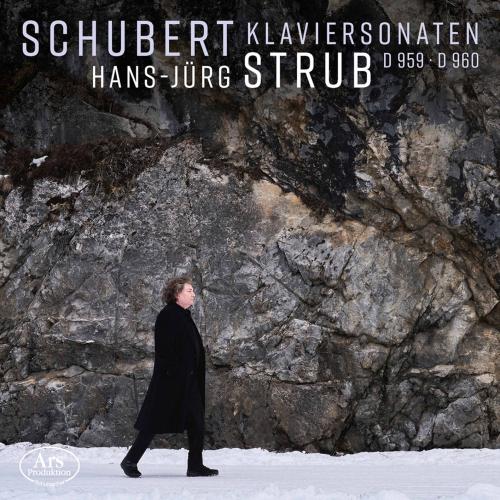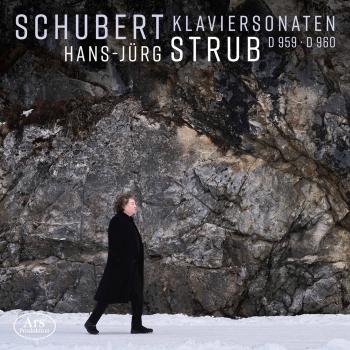
Schubert: Piano Sonatas, D. 959 & D. 960 Hans-Jürg Strub
Album info
Album-Release:
2020
HRA-Release:
18.09.2020
Label: Ars Produktion
Genre: Classical
Subgenre: Instrumental
Artist: Hans-Jürg Strub
Composer: Franz Schubert (1797-1828)
Album including Album cover Booklet (PDF)
- Franz Schubert (1797 - 1828): Piano Sonata in A Major, D. 959:
- 1 Piano Sonata in A Major, D. 959: I. Allegro 16:46
- 2 Piano Sonata in A Major, D. 959: II. Andantino 06:53
- 3 Piano Sonata in A Major, D. 959: III. Scherzo. Allegro vivace 05:12
- 4 Piano Sonata in A Major, D. 959: IV. Rondo. Allegretto 11:55
- Piano Sonata in B-Flat Major, D. 960:
- 5 Piano Sonata in B-Flat Major, D. 960: I. Molto moderato 21:27
- 6 Piano Sonata in B-Flat Major, D. 960: II. Andante sostenuto 09:38
- 7 Piano Sonata in B-Flat Major, D. 960: III. Scherzo. Allegro vivace con delicatessa 03:49
- 8 Piano Sonata in B-Flat Major, D. 960: IV. Allegro ma non troppo 08:45
Info for Schubert: Piano Sonatas, D. 959 & D. 960
A few weeks before Schubert's death in November 1828, the last two piano sonatas, A major D 959 and B flat major D 960, were written, which together with the C minor Sonata D 958 belong to the ""Sonata Triad"" - which can probably be called the crowning achievement of his piano work. Schubert's first draft shows how the thirty-one-year-old worked on these works simultaneously; also, the counting of B flat major as Sonata No. 3 is by Schubert's hand. The sonatas are thus cyclically arranged by the composer and have many compositional similarities. Schubert dedicated this triad to his famous contemporary, the virtuoso pianist and Mozart student Johann Nepomuk Hummel. However, it was not published until 1839 - 11 years after Schubert's death, by which time Hummel had already passed away, and so the dedication was transferred to Robert Schumann by the publisher Diabelli & Co. While the Impromptus or Moments musicaux were always very popular, the sonatas led a shadowy existence for a long time. In both sonatas we experience a wealth of different characters and contrasting emotions. The arc of tension leads from the greatest brightness to the deepest darkness, from powerful verve and chromatic turmoil in the Allegro of the A major Sonata to cantabile immersion and tenderness in the Molto moderato of B flat major. In the slow movements - the F minor Andantino in A major as well as the Andante sostenuto in C sharp minor in B flat major - a shattering sadness seizes us - indeed we experience deepest resignation and mental abyss. The wanderer Schubert is drawn to the abysmal.
"On this album, the Swiss Hans-Jürg Strub, professor at the Zurich University of the Arts, is playing the Schubert sonatas D 959 and D 960, which he has prepared meticulously, as his detailed text in the booklet shows. The first two movements of D 959 are very well differentiated and rich in nuances. But I miss the spontaneity, the natural flow in a perhaps too constructed performance. The Scherzo is more spontaneous and the well contrasted Rondo flows very beautifully.
The pianist succeeds excellently in the first movement of the Sonata D. 960, which he gives a wonderfully mysterious character, as if illuminated from beyond. In the incomparable and incomprehensible Andante sostenuto, the pauses, the moments of silence, the tragic emptiness of the music become particularly effective.
Another very spontaneous and delicately formulated Scherzo and a Rondo, which Strub makes very cheerful and playful, bring this excellent interpretation to a close.
And so these two performances can be described as those of a serious servant of the music who illuminates every corner of this wonderful music, so that no idea of the composer is overlooked. That this can sometimes be at the expense of spontaneity and tension is shown by the first two movements of the Sonata D. 959. But all in all, Strub’s playing is quite interesting." (pizzicato.lu)
Hans-Jürg Strub, piano
Hans-Jürg Strub
Born in Winterthur, Hans-Jürg Strub was taught by Christoph Lieske at the Winterthur Music Conservatory until the age of 18. During this time, he won various competitions. At the age of 14 he made his debut with orchestra and at 16 he gave his first piano recital, after which folllowed several recordings for Swiss Radio. Hans-Jürg Strub went on to study piano at the Music Academy in Hannover and graduated in 1985, receiving his Concert Diploma under Prof. Hans Leygraf.
Workshops with Tatjana Nikolajewa, Gaby Cassadesus, and especially the Bartók-Seminar in Szombathely with Zoltán Koscis and György Kurtág made a lasting impression and have continued to influence his musical development.
In 1981 he won 3rd prize at the International Piano Competition in Jaén and one year later attained second place in the German Music Academy Competition. Hans-Jürg Strub was subsequently sponsored for several years through grants from the "Kiefer Hablitzel-Foundation" and the "Migros Co-operative Society". He is a threefold prize-winner of the "Concours Piano 80" and was awarded the silver medal in the "Festival International de Jeunes Solistes" 1986 in Bordeaux.
After several years of teaching at the Music Academy in Hannover, in 1988 Hans-Jürg Strub began teaching a class of solo- and concert-undergraduates at the "Zürcher Hochschule der Künste".
In 1995 and 1996 he lectured at the interpretation workshop "J.S. Bach's cantabile way of playing", in 1997 he led masterclasses in Japan, founded the Interpretation Course Schloss Weidenkam in 1999, and since 2002 he leads masterclasses in Tbilisi (Georgia), where he was bestowed a honorary professorship in 2006.
Hans-Jürg Strub leads an active professional life as a soloist and chamber musician. Apart from performing in Switzerland, his main engagements are in Germany and Japan. Performances have been, among others, with the "Tonhalle Orchestra Zürich" and the "Winterthur City Orchestra". Releases on CD include a live recording of Rachmaninov's Piano Concert No. 2 and piano solo works of Mozart, Berg, Brahms and Schumann.
Booklet for Schubert: Piano Sonatas, D. 959 & D. 960










